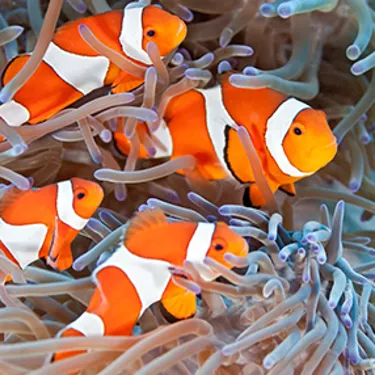Facts About Clownfish
- Monday 18th November 2024

Meet the Clownfish at Our Aquarium
In Clownfish Kingdom, you can come nose-to-fin with some incredible underwater species including the popular clownfish.
Take a peek and you will see the coral reef; a kaleidoscope of colour, bustling with activity! These sea cities are teeming with fish which come in every shape, colour and pattern you can imagine. This is the home of our cute clownfish hiding in the tentacles of Sea Anemones - see if you can spot one!
Facts about Clownfish
If you’ve seen the film Finding Nemo, you likely know a little bit about clownfish - but there are so many more interesting and unexpected clownfish facts to discover!
Where do Clownfish Live?
Clownfish live in the warm, shallow waters of the Indian and Pacific Oceans. They are most commonly seen in regions like the Great Barrier Reef off the coast of Australia, the waters of Southeast Asia, Japan, and the islands of the Indo-Pacific.
How do Sea Anemone Protect Clownfish?
Clownfish find their home in sea anemones, forming a symbiotic relationship that offers mutual benefits. Sea anemones protect clownfish from predators using stinging tentacles, while the clownfish helps keep the anemone clean by eating debris and parasites. This partnership allows clownfish to thrive in specific coastal reef habitats, where they are safe from larger marine animals.
Clownfish Colour
Clownfish are known for their striking and vibrant colours, which can vary across species. The orange clownfish is probably the most iconic, with its bright orange body and white stripes edged in black. However, there are other stunning variations within the species. The black and white clownfish features bold black bodies with white stripes, while purely black clownfish have deep, dark coloration with subtle white markings. Additionally, the rare blue clownfish stands out with a bluish hue that makes it particularly unique among its relatives.
What do Clownfish Eat?
Clownfish are omnivores, meaning they eat both plants and animals. Their diet consists mainly of algae, zooplankton (tiny animals that live in water) and small crustaceans. While clownfish are generally protective of their eggs, there are instances where clownfish eat their own eggs if they sense the eggs are unhealthy or not viable.
Do Clownfish Change Genders?
All clownfish are born boys! In a clownfish group, the largest and most dominant individual is the female, while the second largest is the breeding male. If the female dies or is removed, the breeding male will change into a female to take her place, and the next largest male will become the new breeding male.
How Long Can Clownfish Live For?
Clownfish can live for different lengths of time depending on whether they are in the wild or in captivity. In the wild, clownfish generally live for around 6 to 10 years, though their lifespan can be influenced by factors like predators, environmental conditions, and availability of food. However, in captivity, where they are protected from predators and have consistent care, clownfish can live significantly longer, sometimes reaching up to 12 to 15 years or more.
Types of Clownfish
Black Clownfish
The black clownfish is a striking variation of the well-known clownfish species, distinguished by its deep black body and contrasting white stripes.
White Clownfish
The white clownfish is a rare and visually captivating variation of the clownfish species, characterised by its predominantly white body, often with subtle hints of black or orange around its fins and edges.
Percula Clownfish
Arguably the most iconic, the Percula clownfish, or orange clownfish, is easily recognised by its bright orange body adorned with white bands outlined in black. Their distinct coloration and playful nature make them a favourite among marine enthusiasts, offering a glimpse into the fascinating world of ocean ecosystems.
Storm Clownfish
The storm clownfish is a striking variation of clownfish, known for its bold white patches against a dark black or orange body. They’re native to the warm waters of the Indo-Pacific region, and have been selectively bred to create their unique colourway.
Discover on Your Visit
When you visit the SEALIFE Birmingham Aquarium, look forward to seeing the most amazing sea creatures and oceanic ecosystems. Plus, you can discover:
- How shy and secretive clownfish are
- Why clownfish eat marine flake foods, small shrimp
- How fast the clownfish dash around their kingdom!
- The difference between black and white clownfish
- Our clownfish Aquarium